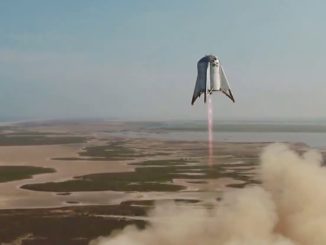
United Launch Alliance is set to try again to launch a Delta 4-Heavy rocket and a classified U.S. government spy satellite Thursday after delays of more than three months caused by persistent issues with the mission’s launch pad.
The mission is set to take off at 6:15 p.m. EST (2315 GMT) Thursday from pad 37B at the newly-renamed Cape Canaveral Space Force Station in Florida. Forecasters predict near-ideal weather with a 90% chance of favorable conditions during the launch window Thursday evening.
The Florida launch base, formerly known as Cape Canaveral Air Force Station, was officially renamed Wednesday during a visit by Vice President Mike Pence. Nearby Patrick Air Force Base was also renamed as Patrick Space Force Base.
The new names reflect the next step in the evolution of the U.S. Space Force, which was established nearly a year ago to take over most of the Air Force’s space operations.
The Delta 4-Heavy rocket is set to haul a top secret payload into orbit for the National Reconnaissance Office, the U.S. government’s spy satellite agency. The mission is codenamed NROL-44.
ULA, a 50-50 joint venture between Boeing and Lockheed Martin, first tried to launch the Delta 4-Heavy rocket in late August.
The launch company’s original launch date for the NROL-44 mission was Aug. 26. A pneumatics issue prevented the rocket from launching Aug. 27, and the Aug. 29 countdown stopped when the automated launch sequencer detected a problem with a pressure regulator on the launch pad designed to flow helium gas to spin up rocket’s center engine for ignition.
The regulator for the center engine did not open, prompting the countdown’s computer controller to stop the countdown during thee engine startup sequence.
Bruno said that engineers refurbished and tested all three pressure flow devices at pad 37B before proceeding with another launch attempt.

ULA set Sept. 26 for the next launch attempt for the NROL-44 mission, but officials delayed the mission again to investigate a concern with the swing arm retraction system at the Delta 4-Heavy’s seaside launch complex at Cape Canaveral. The swing arms, which feed liquid propellants and conditioned air to the vehicle, are designed to quickly retract away from the rocket at liftoff.
Bad weather and a hydraulic leak in hardware associated with the launch pad’s mobile gantry forced ULA officials to call off a pair of launch attempts in late September.
Another launch attempt Sept. 30 was halted at T-minus 7 seconds, just before ignition of the rocket’s three hydrogen-fueled RS-68A main engines. Engineers traced that problem to a bad sensor reading involving a valve position inside one of the RS-68A engines.
While that problem was resolved, ULA encountered deeper issues with the swing arms at pad 37B. Three swing arms feeding propellants and conditioned air to the rocket and its satellite payload are designed to retract as the Delta 4-Heavy lifts off.
Tory Bruno, ULA’s president and CEO, tweeted that technicians drained 2,000 gallons of oil from the hydraulic swing arm retraction system. Teams replaced several dozen valves and “several other important items” before recharging the system with fresh hydraulic fluid, Bruno tweeted.
“Mission success is the priority,” he added.
The repeated problems with different parts of the Delta 4-Heavy’s launch pad have raised questions about aging infrastructure at pad 37B, which was originally built to support Saturn rocket launches in the 1960s, then mothballed until Boeing took over the facility in the 1990s for the Delta 4 program.
Boeing built the towering mobile gantry for the Delta 4 rocket, along with a then-new fixed umbilical tower with the three huge retractable swing arms.
ULA is retiring the Delta 4 rocket family after five more launches — three more from Cape Canaveral and two froom Vandenberg Air Force Base in California. The company’s next-generation Vulcan Centaur rocket, scheduled to debut in the second half of next year, will replace ULA’s existing Delta 4 and Atlas 5 launch vehicles.
While SpaceX’s Falcon Heavy rocket is significantly less expensive and can lift heavier payloads into low orbits, the Delta 4-Heavy has demonstrated an ability to inject satellites directly into high-altitude circular geosynchronous orbits more than 22,000 miles (nearly 36,000 kilometers) above Earth.
The maneuvers required for such an orbital injection take place over roughly six hours. While the payload on the NROL-44 mission is classified, independent analysts say publicly-known parameters such as the rocket’s capabilities, its launch azimuth, and the launch window suggest the Delta 4-Heavy is set to carry a signals intelligence satellite into geosynchronous orbit.
In that orbit, the satellite is expected to unfurl a giant football field-sized antenna to eavesdrop on telephone calls and other data traffic from U.S. adversaries.
The Delta 4-Heavy also has a larger payload fairing than the Falcon Heavy, and the mobile shelters at Cape Canaveral and Vandenberg allow ground crews to mate satellites to the rocket in a vertical orientation. SpaceX plans to offer an enlarged payload shroud on the Falcon Heavy and build a vertical integration hangar at the Kennedy Space Center to support future national security missions that can currently only fly on the Delta 4-Heavy.
Email the author.
Follow Stephen Clark on Twitter: @StephenClark1.



